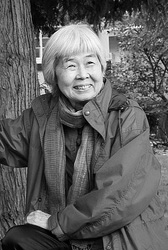Joy Kogawa: Exercise 1 - Reading and Vocabulary
Read the story and answer the questions.
Click on the box beside the correct answer.
The Story of Joy Kogawa
 1 Joy Kogawa remembers her childhood home in Vancouver fondly. The house always had the smell of wood burning in the fireplace. The walls were covered with paintings, photos, and bookcases. The sounds of music, storytelling and laughter sailed through the air. Her bedroom had toy boxes filled with cars, dolls, and games. A cherry tree stood in the yard outside her window. But her happy days there were cut short.
1 Joy Kogawa remembers her childhood home in Vancouver fondly. The house always had the smell of wood burning in the fireplace. The walls were covered with paintings, photos, and bookcases. The sounds of music, storytelling and laughter sailed through the air. Her bedroom had toy boxes filled with cars, dolls, and games. A cherry tree stood in the yard outside her window. But her happy days there were cut short.2 In 1941, a warplane from Japan dropped a bomb on the United States. Canada went to war with Japan. The prime minister of Canada thought that Japanese Canadians might be spies. So he had all Japanese Canadians taken from their homes. They were sent to live and work in camps. To pay for the camps, their homes and belongings were sold. Most of the people sent to the camps were born in Canada. Half of them were under the age of 19. Both the RCMP and the military agreed the prime minister’s decision did not make sense. But the prime minister did it anyway. He wanted Canada to be mostly for white people. He hoped the Japanese Canadians would just go back to Japan.
3 Joy Kogawa was just six years old when her family was forced from their home. They were put on a train and shipped to a camp in Slocan, British Columbia. The family had to live in a one-room shack. It was a heat trap in the summer and an ice box in the winter. Her family was forced to work on a farm. Joy had to work alongside them in the beet fields – often instead of going to school. She dreamed of going back to her home in Vancouver.
4 After the war, Joy did not want to be thought of as Japanese. She thought of herself as a white person. It was a way of trying to forget the painful past. One day, Joy came across some letters. They were written by a Japanese Canadian woman from Vancouver and sent to her brother in Toronto. The letters were about how terrible it was to live in a time of so much racism. The writer called for justice. These letters gave Joy an idea. She decided to write a story based on what had happened to her family. She wrote a book called Obasan. As she wrote it, she began to accept herself as Japanese Canadian. And she began to want justice, too.
5 Joy began to work for justice for the Japanese Canadians who had been put in camps. She worked with others to hold meetings, write letters, and organize rallies. Her book, Obasan, helped people across Canada to understand the terrible things that had happened. Finally, in 1988, the federal government said it was sorry for what had happened. It paid back part of what had been taken from Japanese Canadians. It promised to work to make sure such a terrible injustice never happens again.
6 In 2005, Joy’s childhood house in Vancouver was going to be torn down. Joy helped raise enough money to buy it back. To this day, the house still stands as a reminder of the injustice of racism and war. If we remember our past, we can avoid making the same mistakes in the future.
Credits:
Story by Shantel Ivits at BC Open Textbooks
Adapted under Creative Commons license
Adaptations and exercises by Richard Carrington, English Language Centre
Photo: Joy Kogawa by monnibo is used and adapted under a CC BY-NC-ND 2.0 license.
Audio version performed by Peter Polgar, English Language Centre
Story by Shantel Ivits at BC Open Textbooks
Adapted under Creative Commons license
Adaptations and exercises by Richard Carrington, English Language Centre
Photo: Joy Kogawa by monnibo is used and adapted under a CC BY-NC-ND 2.0 license.
Audio version performed by Peter Polgar, English Language Centre

